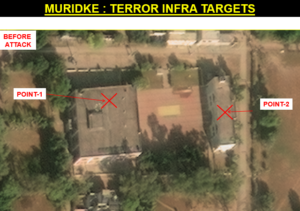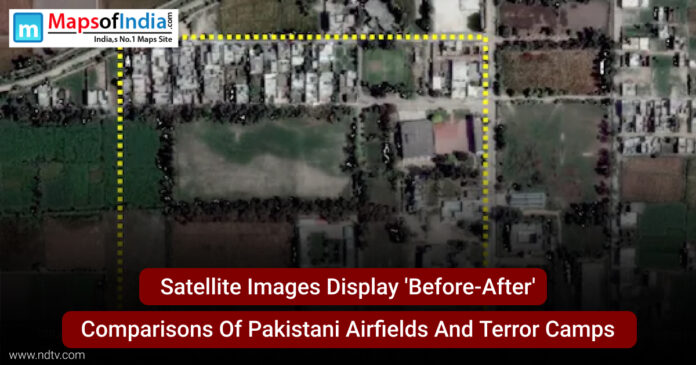Satellite Images Display ‘Before-After’ Comparisons of Pakistani Airfields and Terror Camps
In the path of escalating provincial pressures following cross-border walkouts and secret drone action, just-removed high-resolution satellite imagery has revealed important structural modifications at several Pakistani airbases and known terrorist training camps. These before-and-after images—captured between May 1 and May 11, 2025—show general damage, hurried evacuations, and effective military mobilisation across Pakistan’s strategic locations, growing both alarm and scrutiny from defence judges, spying instruments, and global powers monitoring South Asia’s simmering conflict.
Airfields Damaged in Targeted Strikes
Imagery sourced from private spying satellite enterprises and verified by independent military judges has indicated that at least four Pakistani military airbases—including Murid, Mianwali, Masroor, and Jacobabad—have experienced visual damage in line with accurate air or drone strikes. Satellite access before May 5 depicts normal functional layouts with aircraft lined in parking bays, available hangars, and ground support vehicles.
However, comparison shots post-May 8 show burned tarmac, tumbled shelters, charred rubble, and quick runway closures. In one memorable image of Mianwali Airbase, three JF-17 Thunder aircraft seem to have sustained direct hits. Similarly, hangars at Masroor Airbase near Karachi are visibly crushed, with plumes of moisture seen in heat-map overlays organised during evening surveillance.
According to a senior official in an unnamed Western intelligence agency, “These sites were likely chosen for their strategic roles in supporting drone deployment, refuelling Pakistani surveillance aircraft, and possibly aiding logistics to terror camps in Pok [Pakistan-occupied Kashmir] and Balochistan.
Terror Camps in Pok and Balochistan Suffer Direct Hits

Beyond conventional military sites, the most concerning revelations emerge from images of militant training facilities. Four camps, two in Pok near Muzaffarabad and two in the rugged terrains of southwestern Balochistan, have been partially or destroyed.
Imagery of the Kotli camp in Pok shows what once was a cluster of barracks and parade grounds, now reduced to smoking craters. Several human profiles are absent in the May 11 photos, indicating evacuation or fatalities. The double Pok camp near Chakothi, known to train infiltrators for functions in Jammu and Kashmir, displays signs of destruction in the main exercise yard and weapons depot. Burned-out supply trucks are visible on neighbouring dirt roads, implying a swift retaliatory reaction that may have been expected or continuing.
In Balochistan, satellite footage captures damage to camps allegedly used by the Jaish-ul-Haq and Lashkar-e-Taiba splinter groups. Thermal imaging shows persistent fire hotspots several days after the presumed strikes.
Indian Military Sources Claim Responsibility
While New Delhi has not officially confirmed responsibility, several high-ranking Indian defence officials, speaking off-record, suggested these were “deep precision strikes” carried out by air and drone units between May 6 and May 10. The Indian Air Force (IAF), fresh from participating in its naval-air exercise in the Arabian Sea, reportedly deployed long-range drones and satellite-guided munitions for the missions.
One retired Indian Air Marshal stated, “These strikes were not random. They were part of a calibrated operation to degrade Pakistan’s asymmetric warfare capacity and signal that the use of proxy elements comes with a strategic cost.”
Indian television channels have broadcast portions of the satellite images, claiming that some of the high-value targets eliminated include the control centres of major terror outfits.
Pakistan’s Response: Denial and Mobilisation
Pakistan’s Ministry of Defence, in a strongly worded statement on May 10, rejected all allegations of military facility damages and branded the satellite images as “digitally manipulated disinformation.” However, subsequent movements observed in newer satellite photos suggest otherwise.
On May 9, fresh construction efforts were observed at Masroor Airbase—presumably to rebuild critical infrastructure. Additionally, convoys of military vehicles were spotted redeploying from Lahore to bases near Bahawalpur and Multan. The Pakistani Army also commenced its aerial drills titled “Operation Ghazwa Shield” the same day, aimed, according to local media, at “enhancing retaliatory preparedness.”
Despite official denials, Pakistan’s military command has quietly placed its Strategic Forces Command on a high-alert posture. Civil aviation authorities have closed airspace near Multan and Rahim Yar Khan, and several civilian flights have been rerouted as of May 11.
Expert Analysis: Tactical Victory or Strategic Gamble?
Protection judges remain divided over the importance of these strikes. While some argue that the damage to airbases and terror camps represents a tactical success for India, others warn of a broader escalation wave that may draw in international actors.
“Satellite imagery is the new battlefield front,” said Professor Carla Jenkins, a military intelligence analyst at King’s College London. “The transparency it provides increases accountability but also accelerates retaliation cycles. India has, without saying it outright, signalled a shift from reactive to preemptive posture.”
Others highlight the risks of “satellite diplomacy,” in which the public release of images forces adversaries to respond publicly, even if reluctantly, to avoid perceived weakness.
China and the US Monitor Closely
Given the strategic proximity of Chinese investments and infrastructure under the China-Pakistan Economic Corridor (CPEC), Beijing has voiced concern. On May 11, the Chinese Foreign Ministry called for “maximum restraint and de-escalation by all parties.” China has reportedly increased its satellite surveillance of Balochistan and deployed a PLAN surveillance vessel off Gwadar Port.
The United States, meanwhile, remains in contact with both Islamabad and New Delhi. Secretary of State Antony Blinken spoke with Pakistani Foreign Minister Ishaq Dar on May 10 and followed up with Indian External Affairs Minister S. Jaishankar the next day. Washington’s primary concern remains the safety of Afghanistan-border operations and keeping nuclear thresholds intact.
Public Discourse and Propaganda War
Beyond the battlefield, both nations have engaged in an intense media and information warfare campaign. Indian networks hailed the satellite image releases as “undeniable proof of Pakistan’s duplicity,” while Pakistani media have largely downplayed the images and questioned their authenticity.
Social media platforms, especially X (formerly Twitter), have become battlegrounds for viral side-by-side image comparisons. Independent journalists and OSINT (Open-Source Intelligence) groups have also contributed by geo-tagging locations, confirming timestamps, and pointing out anomalies.
Some neutral experts have warned against over-reliance on such imagery without cross-verification. “A satellite image tells you what happened, not necessarily why it happened or who did it,” noted Ellen McCarthy, former director of intelligence at the U.S. State Department.
Impact on Regional Stability
The long-term impact of the walkouts may be a hardening of jobs on both sides of the border. Already, infiltration across the LoC (Line of Control) has increased, according to Indian Army reports. Pakistan’s Rangers and Indian BSF (Border Security Force) have encountered several respite breaches since May 9, promoting fears of localised conflict escalation.
Afghanistan, already grappling with internal fluctuation, has expressed worry over spillover effects, particularly if cross-border militancy intensifies. Iran has reportedly increased patrols near its border with Balochistan as a protection measure.
Conclusion
The release of satellite imagery depicting the extent of destruction across Pakistani terminals and demon camps marks a powerful point in South Asia’s growing competition paradigm. It reflects a new phase in warfare, one where visibility and clarity, helped by satellite technology, force not just service products but political narratives.
As both India and Pakistan weigh their next moves, the globe watches closely. The stakes are not just tactical; they are extremely strategic. The question now is whether these images will be recognised as the moment deterrence was re-established, or when it died down altogether.




